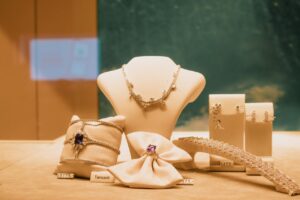
Image from Pexels
A diamond is one of the most coveted items in the jewelry industry, representing a person’s love, dedication, and social standing. Investing in a diamond is a significant purchase that requires careful consideration. To help you make a well-informed selection, here are 10 facts about diamonds you should know.
Things to Think About When Buying a Diamond
Understanding the 4 C’s
Diamond buyers must check for the 4 Cs (cut, carat weight, clarity, and color):
- Cut determines diamond brightness and fire.
- Carats determine the diamond’s price.
- Clarity determines a diamond’s appearance and value.
- Near-colorless diamonds are the most valuable.
These four factors affect the diamond’s value and appearance, so examine them before buying. Choose a diamond with a good cut, clarity, and color to maximize value. You may find an exquisite and affordable diamond if you prioritize these factors.
List of 10 Things to Know Before Buying a Diamond
- Cut
Diamond cut matters more than form. Diamond cut and polish enhance its brilliance, and only the most significant cuts can gleam. The Gemological Institute of America (GIA) assigns a cutting-quality rating of Brilliant, Very Good, Good, Fair, or Poor to each diamond it examines. Your diamond should be an Excellent or Very Good cut.
- Carat Weight
Carats are the standard unit of diamond weight, and there are 0.2 grams in a carat. There is a direct correlation between diamond size and price. Diamond value is based on more than carat weight, and a higher cut quality may increase the value of a smaller diamond.
- Clarity
Deficiencies and defects are what affect a diamond’s clarity. Surface flaws differ from internal inclusions, which are invisible to the naked eye. GIA grades clarity from Flawless to Included on a scale from Flawless to Included (I1, I2, I3). Diamonds graded as SI1 or SI2 clarity are flawless to the naked eye.
- Color
Diamonds are classified in color from D (colorless) to Z (very pale) (yellow or brown). Diamonds with fewer inclusions are more valuable. It all comes down to personal preference. However, some people choose yellow or orange diamonds. Select a diamond with a G grade.
- Certification
Only purchase certified diamonds. The 4Cs of a diamond is evaluated objectively and presented in a diamond certificate (cut, carat weight, clarity, and color). Some groups ensure that a diamond’s quality matches its description.
- Shape
Every individual has a unique diamond shape. Standard shapes include rounds, princess cuts, cushions, ovals, and pears. The shine, brilliance, and overall appearance of each form are unique. Put on a few different forms before deciding.
- Setting
Diamonds are set in metal bezels. Prong, bezel, and pave settings predominate. Both the sparkle and safety of a diamond depend on the setting. Prong settings let more light into the diamond, increasing its brilliance, yet bezel settings are more secure.
- Budget
Money It is essential to set a budget before purchasing a diamond. Diamonds may range in price from the hundreds to the thousands. A budget plan should be created as soon as possible. A diamond’s worth is determined by its four Cs and its certification is essential to set up a budget. The value of a diamond is affected by its 4Cs and its certification.
- Retailer
To that end, choose a supplier you can trust. Try to locate a company with a history of dealing in high-quality stones. Seek out feedback from others and consult with close family and friends. Diamonds come with certifications, and there are return procedures at reputable stores.
10. Maintenance
An uncared-for diamond will quickly lose its luster and sparkle. Keep your diamond sparkling by cleaning it regularly to eliminate oil, dirt, and other particles that might reduce its shine. Cleaning diamonds requires a gentle scrub with a soft bristle brush, little dish soap, and hot water. Never use harsh chemicals or abrasives on the diamond, as they may cause damage.
Diamond Maintenance: How to Keep Your Diamond Shining
After buying a diamond, take care of it to keep it sparkling. Regularly cleaning the diamond preserves and extends its life. A soft bristle brush, a little detergent, and warm water clean diamonds best at home. Trusted jewelers should clean and inspect the diamond yearly. Routine checkups may detect issues like loose settings before they damage or lose a diamond. Unprotected diamonds may scratch or break. Follow these maintenance guidelines to keep your diamond sparkling for years.
Lastly
Purchasing a diamond may be a thrilling and worthwhile adventure. This list of 10 things to consider when shopping for a diamond will help you choose a stone that fits your needs without breaking the bank. Remember the 4Cs (cut, carat weight, clarity, and color) and the certification, shape, setting, and merchant when making your purchase. With care, your diamond will shine brightly for many years to come.


